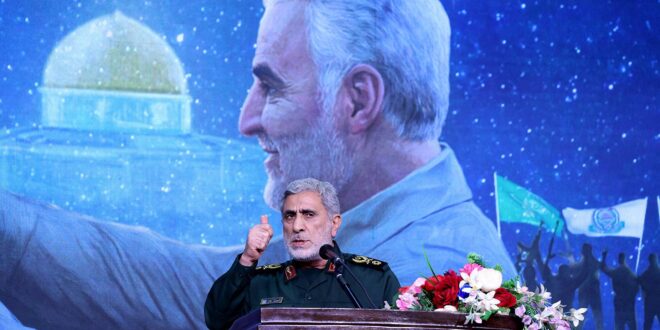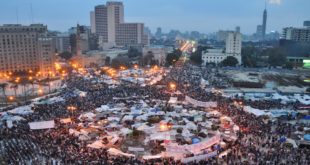As Tehran moves toward consolidating its regional power, will it agree to ultimately disarm its Arab allies? Can it afford not to?
Reports in recent weeks as the Gaza war continues indicate that Iran has asked its allies throughout the Middle East to pause their attacks against U.S. forces, fearing this could draw it into a conflict with the United States. The Iranians have been calculating in their approach to Gaza, showing the breadth of their influence through allies in Lebanon, Yemen, and Iraq, while stopping short of provoking a regional conflagration that might implicate Iran and destroy its most valued assets.
The new regional order has shown that Iran cannot be circumvented. The United States has all but acknowledged this fact, whether under the Obama and Biden administrations, or under former president Donald Trump, who failed to retaliate for Iran’s targeting of Saudi oil facilities in September 2019. Trump’s admirers applauded him for pulling out of the Joint Comprehensive Plan of Action, the nuclear deal with Iran, but have maintained a stony silence since as Tehran has advanced its nuclear program. Nor were they anywhere to be found when the Iranians bombed the Saudi oil processing facilities in Abqaiq and Khurais, after which Trump could only meekly affirm that he sought “to avoid war” with Iran.
An idea former president Barack Obama promoted is coming to fruition. In an interview with the Atlantic in April 2016, Obama stated, “The competition between the Saudis and the Iranians—which has helped to feed proxy wars and chaos in Syria and Iraq and Yemen—requires us to say to our friends as well as to the Iranians that they need to find an effective way to share the neighborhood and institute some sort of cold peace.” The Chinese-sponsored reconciliation between Saudi Arabia and Iran last year was the first sign that such an outcome was possible, and developments in Iraq, Syria, Lebanon, and Yemen have since confirmed this.
Yet for all the recognition of Iran’s growing regional sway, one thing is equally evident. Wherever the Iranians have asserted their power, the results have been catastrophic. Observers have described the pro-Iran network of regional political-military actors as an “axis of resistance,” but the reality is that everywhere it is primarily an axis of ruin. Syria and Yemen are devastated; Iraq is dominated by pro-Iran militias that have prevented the emergence of a functional state and undermined elections; in Lebanon Hezbollah has protected a political class that brought on an economic collapse while derailing economic reforms; and in Gaza, Iran’s allies have caused a war that has ravaged the territory. Wherever Arabs look, the Iranian model has bolstered Iran’s power but left Arab societies in misery.
That has to change if Iran seeks to consolidate itself in the region. Other than in Iraq, the Iranian strategy of backing cohesive, armed minorities (numerical or sectarian) against divided majorities has been highly effective, but it does not represent a sustainable long-term project. For example, in Syria and Lebanon it is plain to Iran and its allies that both countries will not be revived without considerable assistance from the predominantly Sunni Gulf Arab countries—until not so long ago Tehran’s main regional rivals. The horrific levels of damage and suffering in Gaza are such that it has probably been neutralized as an Iranian pressure point on Israel. This lends credence to the view that while Iran may have helped prepare the attack of October 7, 2023, it had not signed off on the timing.
There are signs that Iran is aware of the shortcomings of its approach, the most notable one being the agreement with Saudi Arabia. At the same time, the Iranians have also reached the outer limits of their influence, so that more conflict is not necessarily in their interest. There is little more to gain now that they are playing a leading role in Lebanese, Syrian, Yemeni, Iraqi, and Palestinian affairs. If anything, unless they consolidate their power by allowing these societies to stabilize and progress, it is more than probable that their authority will erode.
Yet built into Iranian power structures in the region is an inherent tension. What allows Iran’s allies to remain in dominant positions at home is their weaponry. Even as Iran may be willing to compromise with other countries to revitalize places such as Lebanon, Syria, Yemen, Iraq, and Palestine, their tendency will be to maintain affiliated armed groups in place to guarantee Iranian clout. In the pluralistic, often multisectarian, societies of the Arab world, this implied threat will only generate growing resentment of Iran’s allies, complicating its consolidation process.
In light of this, what can the Iranians do? If they gradually move away from their militia allies in favor of state-to-state relations with the Arab countries in which they have a say, they risk seeing their power fray. As unwelcome as this may be, it is the only real option that Iran has. The Iranians have the money and cultural baggage to compensate with soft power, while perhaps realizing that by failing to disarm their allies in the end, the states in which they are active will remain dysfunctional, causing a negative backlash against Tehran.
Whichever path Iran chooses, we are already in the process of seeing some significant shift on its part. The Iranians’ choices in the region will likely follow from domestic dynamics, but will also be tied to Tehran’s external relationships. China’s influence in particular will be decisive, since Beijing has become a factor of stability in a region in which it has major economic stakes. As the Chinese seek more secure access to the region’s hydrocarbons and advance their Belt and Road Initiative, Iran may well have to accommodate them. This, in turn, could affect the activities of Iran’s powerful Islamic Revolutionary Guard Corps, for which instability has often created valuable openings to enhance Iran’s reach.
However, without a clear sense of institutional dynamics inside Iran, it is difficult to predict what the eventual outcome will be. Iran is at an essential moment in its decades-long effort to move to center stage in the Middle East, but it also faces mistrust and resentment in many Arab societies. How it addresses this situation and the conflicting demands of power will define the region in the coming years.
 Eurasia Press & News
Eurasia Press & News



